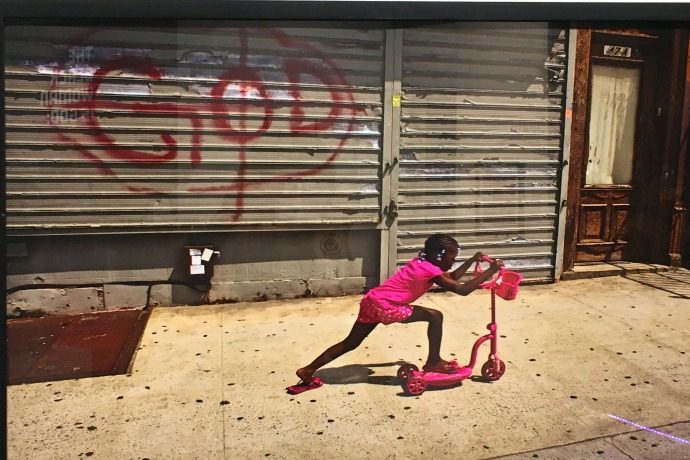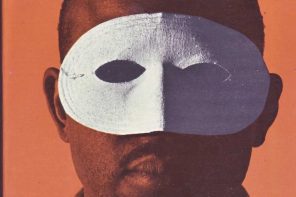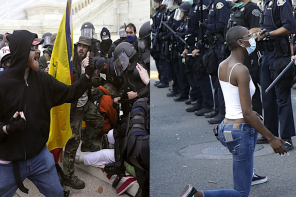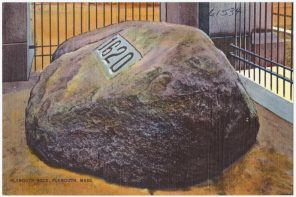The moment I entered the Black Woman is God exhibit in San Francisco’s SOMArts gallery, I knew I was on sacred ground. I found myself treading gingerly, trying not to disturb the spirits of ancestors that seemed to repose in every nook and cranny of the display rooms.
Holding more than 100 pieces of artwork from 60 intergenerational black women artists, the space manifested pain and resistance but also affirmation and jubilation.
I glimpsed the past in Orisha imagery, the present in a cross bearing the names and pictures of black women killed by police, and the future in a chalk mural depicting the black womb as a stargate to another, better world. When I instinctively genuflected at an installation of a black Madonna, I understood that I wasn’t in an art exhibit, I was in a temple.
Curators Karen Seneferu and Melorra Green took over a year to build this collection, bringing together artists from all over the Bay Area and finding paintings, sculptures, films and installations that elevated black womanhood.
I had the opportunity to walk through Black Woman is God: Reprogramming that God Code with Oakland native Seneferu and to ask her about the artwork and the movement it means to inspire.
_________
Anita Little: Can you tell me more about what led you to curate this unbelievable collection?
Karen Seneferu: I’ve been fortunate enough to be in gallery spaces or museums where I was able to show my own artwork, but I was either the only black artist or the only black female artist in an exhibition. Being able to go into a space and take it over is very important to me, so I found it problematic that I was always the only voice representing the whole black community or the black female community.
I wanted to create an opportunity for other incredibly talented and skilled black women artists. The only way I would be able to do that would be to create an exhibition that would show various skill levels but also combine luminaries with emerging artists or artists who may have been creating for years but didn’t have access to space.
How did you find the 60 artists?
I was exposed to a number of these artists through an annual exhibition at the Richmond Art Center called The Art of Living Black. That exhibition was created over 20 years ago by Rae Louise Hayward, and I saw art from more than 100 artists throughout the Bay Area who I didn’t even know existed. At that time I wasn’t even creating as an artist and didn’t acknowledge myself as an artist.
When I had the opportunity to showcase women artists, I just went back to that source and these relationships I had built with artists over the past two decades. I really just mined the resource that Hayward had set forth, and I feel I’m following in her footsteps by creating a space like this.
I’m interested in the opportunity of space for black women because black men tend to speak for the black community—whether it’s visual arts, literature or politics. They tend to speak for both genders.
To some degree, Black Lives Matter is shifting that narrative because you have queer black women at the forefront that are really the voice of challenging authority and protecting black bodies. With this exhibition, I wanted a space for black women to talk about how they value themselves against an environment that constantly attempts to dehumanize them and their contributions.
How do the ideas represented in this space help to combat the culturally dominant narrative of a white male deity? Do you see this as a counternarrative to white Christianity?
I wasn’t interested in having that counternarrative because when you do that you’re still within the framework of affirming the iconography of white male dominance. That wasn’t my interest so much as being able to go back and retrieve cultural and historical references of the black female presence within the African diaspora that say the black woman is God. I was more interested in black women taking on that ideology and having them affirm that in a creative way.
But some are saying it’s problematic to even take on this idea of the black woman being God. What are the spiritual ramifications of that for the black woman? Historically, she’s had to take on so much within the community and outside of it, so what does it mean to say she is a god? Can that be a weight? My intention here is not affirming white male presence through denying it, that’s not a positive representation of what’s happening here. It’s really about going back and claiming our roots.
This idea of the black woman as divine, how does it intersect with social justice movements like #SayHerName and social media trends like #BlackGirlMagic and #CarefreeBlackGirl?
I think it’s just timing in some ways. The best way to talk about it is in terms of the reception we held. The reception was on July 7th—just after two very tragic killings of black men and subsequent killings of police officers.
When the reception happened that same week, more than 1500 people showed up and that was really phenomenal. People were looking for a space to heal. When some of them came into this environment, it was more than what they anticipated. Some didn’t seem to know what they were seeing but they knew they were paying witness to something.
I think it’s about this shift of consciousness: that we can’t continue to simply fight the politics of ideas, that the spirit has to be embedded in some level as well.
Ericka Huggins, who was a very important member of the Black Panther Party, told me before the exhibit that politics cannot sustain itself without the spirit. These political movements that are happening are very important, but the undercurrent of these movements is a desire to change the spiritual consciousness of the community first and the society second.
When black women decide to heal, the community heals, and then the society heals. Oftentimes, we’re at the forefront of political and cultural change. There is a need to have a spiritual component connected to these affirmations of the self like #BlackGirlMagic and challenges to white male patriarchy like Black Lives Matter.
Given that the exhibit came out in the year of Lemonade, do you feel the deification of black female bodies is having a heightened moment culturally?
I’m seeing a number of images come out of the 1991 film Daughters of the Dust. We have to pull everything we’re seeing now, especially Lemonade, back to that filmmaker. Her name was Julie Dash. In some ways, Beyoncé has her finger on the pulse of cultural currency and recognizes that in order for her to stay current, she has to see what’s happening in various communities and integrate that into her own global platform. I don’t think it’s so much that we’re following her but that she’s following us. Beyoncé’s getting recognition for it because we just don’t have the same kind of access to the media that she does.
For certain people, she’s reaching them in ways that are important, but is it necessary to transforming the community at that base level? What she’s doing can only be important for a moment, we need something that’s going to be lasting over generations. That’s the kind of deep-seated sickness that the black community and brown community have because of white supremacy and patriarchy. We need something that is pulling back to our essential selves and that will transform us from inside out. Beyoncé can participate, but I don’t think she’s the primary tool to do that.
You said that you see this not only as an exhibit but as a movement-building platform. Now that the exhibit is nearing the end of its run, in what ways do you hope it will continue to inspire?
The best way to answer that question is to go to what people have said to me—and that is they feel the need to create. Now that they know the ability to create is in everyone, they want to tap into their own creativity. I also think they recognize the need to not only heal themselves but to attempt to do that with their families.
The desire is very big now to go back and capture genealogy about their families. We had a genealogy project that was created by Tarika Lewis who was the first female member of the Black Panther Party, and she’s in this exhibit. People were going back and tracing their roots and trying to connect to their families. Not only are they looking at the impact of slavery on their families but also to resistance within the family structure that allowed for them to be here today.
That’s a really important component of this project. People are desiring to heal, but they’re also desiring to affirm the power of resistance to social forces.
It seems a lot of black women who came to this exhibit saw it as a sacred space and described it as similar to going to church. How does this space stand as an alternative to spaces like the black church where black women’s contributions may be stifled or silenced?
First and foremost, it’s not a matriarchal space, but it is a maternal space. It’s a space where anyone can come into it. It’s very important to me to recognize what it means to say that the black woman is God. She has the mitochondria that holds all of the human race in it, she’s the only one who has that. It’s called the Eve gene.
Now what does that mean? It means she has given birth to the entire human race, so anything she produces is universal. If you come into it, it means that you’re a part of that because you’re a part of her, she’s a part of you.
In that sense, it’s not about hierarchy. It’s not about valuing one form or style or presence over another. It’s not about domination or submission to a ruling idea, it’s about inclusion.
Because of that, it moves away from the black church, which is influenced by Western cultural views about religion. The space of black churches is still impacted by white male patriarchy. You can see that in the iconography where Jesus Christ may still be perceived as white. My intention for this space is for everyone to be able to come in and feel invited and recognize some power in themselves, even if they don’t necessarily connect to the images themselves.
Regarding the people coming into this exhibit, especially on opening night, did you feel it was mostly black women or do you feel Black Woman Is God has drawn people from everywhere?
It’s drawn people from everywhere. Predominantly, it’s black women, and that’s because they have just been brutalized in the world in terms of the denial of their value and their contributions while simultaneously having to take care of every ethnic group you can think of.
Since the inception of slavery in Western culture, we have fed and nourished every ethnic group, and in some ways Yetunde Olagbaju’s piece speaks to the burden of that. Whether it’s a white male figure or a black male figure, we have had to take on the burden. Black women who showed up at the reception found a place for themselves where they were appreciated.
A number of the women who showed up were from the black church and a number were deans or presidents of colleges, so it was this really wide range of experiences in this space. I think this is a very historic moment. Where else would you get to see more than 100 pieces of artwork from black women? You don’t. If you went to the de Young museum or to MoMA, you would see one or two pieces from black women artists, but if you don’t know those are black women artists, you may not know what they’re representing. When a group is denied, no matter the ethnicity, I think people are interested in seeing what they have to say.
The title of the exhibit, The Black Woman Is God, what was the inspiration for that?
It was a conversation I had with the co-curator Melorra Green when we were talking about what it means to be a black woman in the world and still stand tall. It’s really an affirmation of the ability not only to endure but also to rise above annihilation. At the root of rising above annihilation is beauty. The ability of black women to claim their beauty in a world that’s constantly saying she is ugly or doesn’t exist is a resistance to annihilation. To me, that can only mean the black woman is God because you have to possess a godlike presence to be able to rise above.
One thing that struck me as I explored the exhibition was the several black Madonnas I saw. Growing up the Catholic church, I had always seen the Madonna represented as white.
Yes, however in Russia and in the Vatican, the Pope pays homage to a black Madonna. Runoko Rashidi, an African scholar who travels all over the world, goes searching for black Madonnas. He has historical documentation of Europeans being very connected to paying homage to the black Madonna, whereas here in this country we know little or nothing about that practice. I’m mentioning black men because we have the opposite gender affirming the black female presence at the highest order.
They’re saying the black woman is God, that she gave birth to humanity. There’s no one more loving, more giving, more healing than the black woman. In order for her to endure so much and still be loving is an indication of her godlike presence.
What are your thoughts on the “I met God, she’s black” shirts that became so popular last year?
When I started seeing those, I became very concerned because it was like: I need to get on this now. My intention was to create “Black Woman Is God” shirts as we were moving forward and developing this project, so when I saw this other shirt, I knew how important it was. I think a lot of people recognize this concept from a biological standpoint (in terms of the mitochondria) but also recognize it in terms of the ways in which the black female presence is honored, especially in Europe.
We’re now at this apex, this pivotal point where there’s a rush of awareness. You see it at the political level with Black Lives Matter where black women are at the forefront. You see it at the Olympic level where black women are taking over certain sports. You see it at the artistic level where people like Kara Walker are getting bigger.
We’re seeing this slow turn towards something that is ancient. The current political framework that is resisting this turn, it’s really the last hurray for them. We’re watching something die violently and the slow move towards something more inclusive.
Earlier you mentioned that some found the idea of the black woman as God problematic because it can run analogous to the “strong black woman” myth that ultimately harms black women, perpetuating the idea that they’re impervious to pain and suffering. What would be your response to that criticism?
That’s a necessary conversation and dialogue. I’m certainly not attempting to encourage them to endure more. My intention is for them to claim themselves and claim their beauty. To me, beauty is the body, so I want them to see the body as a temple and own themselves in public—since that’s where we are denied our presence.
In that way, we become a mirror reflecting what is possible, and it gives us a sense of pride to move forward and rebuild communities and families.
The Black Woman is God: Reprogramming That God Code will be on view at SOMArts (943 Brannan St., San Francisco) until August 17th.





